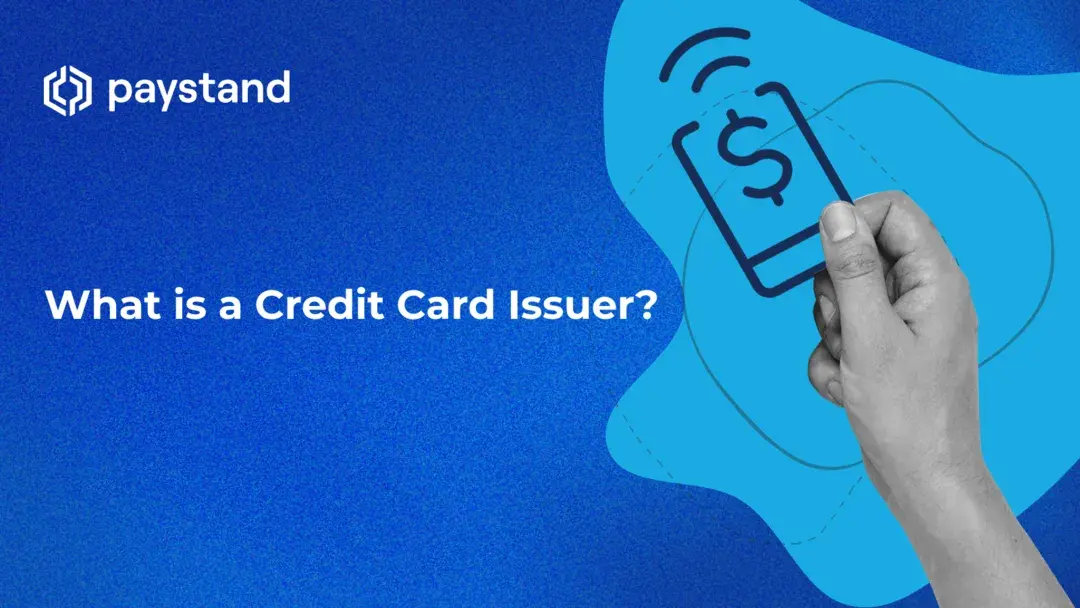What is a Credit Card Issuer?

Table of Contents
- What is a credit card issuer?
- Who can be a credit card issuer?
- How do credit card issuers operate within the payment cycle?
- What do credit card issuers do?
- Eliminate credit card fees with Paystand
Key Takeaways
- A credit card issuer is a financial institution responsible for issuing credit cards, evaluating credit applications, setting credit limits, and managing customer accounts.
- You can find your credit card issuer by checking your statement, contacting customer service, or using online banking.
- Credit card issuers can be banks, credit unions, or other companies that partner with banks, such as retail stores, gas stations, airlines, and hotels.
- Credit card issuers issue cards, manage accounts and handle customer support, while co-branded partners focus on rewards and marketing.
- In the four-party payment model, credit card issuers authenticate and authorize transactions for merchants and cardholders.
- Credit card issuers are distinct from card schemes like Visa and Mastercard, which process transactions and set transaction rules.
Businesses are under increasing pressure to optimize their payment processes. This shift is about more than just faster transactions—it's about increasing cash velocity and improving overall financial efficiency, especially within ERP payments. Credit card issuers, the backbone of many traditional payment cycles, play a significant role in how businesses handle transactions.
However, with the rise of alternative digital solutions, like the Paystand B2B network, businesses can streamline their payment workflows while minimizing costly credit card fees. Keep reading to uncover everything about credit card issuers and how embracing digital payments can propel your business forward.
What is a Credit Card Issuer?
A credit card issuer is a financial institution, such as a bank or credit union, that provides credit cards to consumers and businesses. They are responsible for evaluating credit applications, setting credit limits, and issuing credit cards to approved applicants. Some other key responsibilities are:
- Evaluating credit applications using different factors, such as the applicant's credit score, income, and debt-to-income ratio.
- Setting credit limits for each approved applicant based on their creditworthiness.
- Issuing credit cards to approved applicants.
- Managing customer accounts, including processing transactions, handling billing and payments, and providing customer service.
- Collecting payments from cardholders each month.
- Reporting cardholders' payment history to credit bureaus.
How Do I Know My Credit Card Issuer?
There are a few different ways to find out who your credit card issuer is.
- Look at your credit card statement. It will typically list your credit card issuer's name and contact information.
- Call the customer service number on the back of your credit card. A customer service representative will be able to provide you with your credit card issuer's name and contact information.
- Check your online banking account. If you have online access to your credit card account, you may be able to find the name and contact information of your credit card issuer there.
Who Can Be a Credit Card Issuer?
There are two main types of credit card issuers: banks and credit unions. Banks are for-profit institutions that offer various financial services, including credit cards. Credit unions are not-for-profit institutions that their members own.
To be eligible to become a credit card issuer, a financial institution must meet certain criteria:
- Having a strong financial track record
- Having a large customer base
- Having a good reputation
- Having the ability to manage risk
Once a financial institution meets these criteria, it can apply for a credit card issuer license from the Office of the Comptroller of the Currency (OCC), which regulates national banks that issue credit cards.
Does a Credit Card Issuer Have to Be a Bank?
In addition to banks and credit unions, many other companies can issue credit cards:
- Retail stores
- Gas stations
- Airlines
- Hotels
These companies typically partner with a bank or credit union to provide financing for credit cards and then market them to their customers.
How do Credit Card Issuers Differ From Co-branded Credit Card Partners?
| Aspect | Credit Card Issuer | Co-Branding Partner |
|---|---|---|
| Issuance | Issues the credit card | Does not issue the card |
| Relationship | Works with the co-branding partner | Partners with the credit card issuer |
| Reward Points or Miles | Purchases reward points or miles from the co-branding partner | Assists in issuing rewards to the cardholder's credit card account |
| Customer Support | Handles issues related to the credit card | Handles issues related to rewards |
How do Credit Card Issuers Operate Within the Payment Cycle?
The model that allows payments to be processed via a credit card is often called a four-party or four-corner model. That’s because four main players make these transactions possible:
- The merchant. The business accepting credit cards as payment for goods and services.
- The acquirer. Also known as the merchant acquirer or acquiring bank, is the bank account provided by the merchant’s financial institution; it allows the merchant to accept credit cards as a form of payment from its customers.
- The cardholder. The customer using a credit card to buy goods and services from the merchant.
- The credit card issuer. It issues credit cards to customers so they can use them to make purchases.
When cardholders decide to purchase online, they enter their credit card information into a payment network and submit it. The information is then passed to the merchant acquirer.
The acquirer then passes the information to the card scheme tied to the customer’s card. The card scheme then needs to authenticate the cardholder’s identity and authorize the payment by ensuring enough funds are available on the cardholder’s end to make the transaction. If the cardholder is authenticated and the payment is authorized, the issuer brings this information to the card scheme, passing the approval response to the acquirer.
Then, the acquirer relays this information to the merchant, who confirms that the payment has gone through. Finally, the transaction is complete, and it’s up to the merchant to follow through with delivering the goods and services that the customer paid for to the customer.
What do Credit Card Issuers Do?
When cardholders swipe their cards, they borrow money from a credit card issuer. Credit card issuers are financial institutions that come in many forms, including banks, fintech companies, and credit unions.
Credit card issuers are in charge of setting credit card limits, offering card benefits, charging interest rates and other fees, and issuing new lines of credit. They’re also responsible for approving or declining your purchases and authorizing transactions for the merchant you’re trying to buy something from.
Here are some of the most well-known card issuers:
- American Express
- Discover
- Citi
- U.S. Bank
- Wells Fargo
- Bank of America
- Barclays
Remember that card issuers are separate from card schemes such as Visa and Mastercard.
What is the Difference Between a Credit Card Issuer and a Card Scheme?
| Credit Card Issuer | Card Scheme |
|---|---|
| Issues credit cards to consumers | Sets the rules and standards for credit card transactions |
| Approves or denies credit card applications | Processes credit card transactions and ensures security |
| Sets interest rates and fees | Provides the technology infrastructure for credit card transactions |
| Manages customer accounts and billing | Charges interchange fees to merchants |
| May offer rewards programs and other benefits | May set limits on spending and cash advances |
| Examples: Chase, Citibank, American Express | Examples: Visa, Mastercard, Discover |
Eliminate Credit Card Fees with Paystand
Paystand’s innovative B2B payment network eliminates credit card fees, offering businesses a seamless way to process payments through automated digital solutions. With blockchain-based technology, Paystand improves cash velocity and integrates smoothly with ERP systems, providing a powerful tool to optimize financial operations.
Ready to learn more about how digital payments can transform your supply chain? Download our ebook and take the first step toward a more efficient, cost-effective payment system.





